Non-volatile memory cell comprising a dielectric layer and a phase change material in series
a technology of phase change material and memory cell, which is applied in the direction of digital storage, transistors, instruments, etc., can solve the problems of restricting the usefulness of this approach
- Summary
- Abstract
- Description
- Claims
- Application Information
AI Technical Summary
Problems solved by technology
Method used
Image
Examples
Embodiment Construction
[0025] While all materials can change phase, in this discussion the term “phase change material” will be used to describe a material that changes relatively easily from one stable state to another. The phase change is typically from an amorphous state to a crystalline state (or vice versa), but may be an intermediate change, such as from a less-ordered to a more ordered crystalline state, or vice versa. Chalcogenides are well-known phase change materials.
[0026] It is known to use phase change materials, such as chalcogenides, in a nonvolatile memory cell, in which a high-resistance, amorphous state represents one memory state while a low-resistance, crystalline state represents the other memory state, where memory states correspond to a value of 1 or 0. (If intermediate stable states are achieved, more than two memory states can exist for each cell; for simplicity, the examples in this discussion will describe only two memory states.) Chalcogenides are particularly useful examples ...
PUM
 Login to View More
Login to View More Abstract
Description
Claims
Application Information
 Login to View More
Login to View More - R&D
- Intellectual Property
- Life Sciences
- Materials
- Tech Scout
- Unparalleled Data Quality
- Higher Quality Content
- 60% Fewer Hallucinations
Browse by: Latest US Patents, China's latest patents, Technical Efficacy Thesaurus, Application Domain, Technology Topic, Popular Technical Reports.
© 2025 PatSnap. All rights reserved.Legal|Privacy policy|Modern Slavery Act Transparency Statement|Sitemap|About US| Contact US: help@patsnap.com



